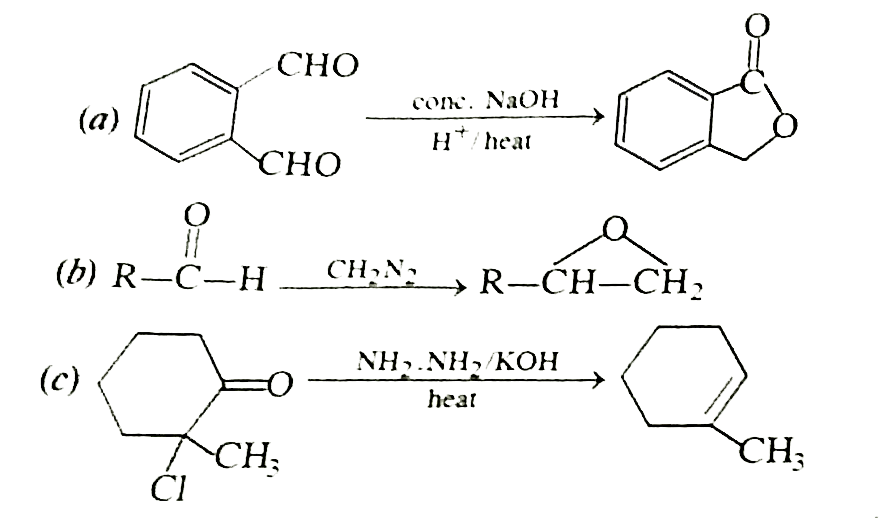How will you bring about the following transformations?
p-Methylacetophenone to benzene-1, 4-dicarboxylic acid (terephthalic acid)
To transform p-Methylacetophenone to benzene-1,4-dicarboxylic acid (terephthalic acid), we can follow these steps:
Step 1: Identify the Structure of p-Methylacetophenone
- p-Methylacetophenone has the following structure:
- It consists of a benzene ring with a methyl group (−CH₃) at the para position and an acetophenone group (−C(=O)CH₃) attached.
Step 2: Oxidation with KMnO4
- The first step in the transformation is to oxidize p-Methylacetophenone using potassium permanganate (KMnO4) in the presence of potassium hydroxide (KOH).
- KMnO4 is a strong oxidizing agent and will oxidize the methyl group (−CH₃) to a carboxylic acid group (−COOH) and the acetophenone group (−C(=O)CH₃) to a carboxylate group (−COOK).
- The reaction can be summarized as follows:
- p-Methylacetophenone + KMnO4 + KOH → p-Methylbenzoate + COOK (potassium salt of carboxylic acid)
Step 3: Acidification
- The next step is to convert the potassium salt of the carboxylic acid into the corresponding carboxylic acid.
- This can be achieved by treating the product from Step 2 with dilute sulfuric acid (H₂SO₄).
- The reaction can be summarized as follows:
- p-Methylbenzoate + H₂SO₄ → Terephthalic acid (benzene-1,4-dicarboxylic acid)
Final Structure
- After the acidification step, we obtain terephthalic acid, which has two carboxylic acid groups at the 1 and 4 positions of the benzene ring.
Summary of the Reaction Steps:
1. Oxidation: p-Methylacetophenone + KMnO4 + KOH → p-Methylbenzoate + COOK
2. Acidification: p-Methylbenzoate + H₂SO₄ → Terephthalic acid
- p-Methylacetophenone has the following structure:
- It consists of a benzene ring with a methyl group (−CH₃) at the para position and an acetophenone group (−C(=O)CH₃) attached.
- The first step in the transformation is to oxidize p-Methylacetophenone using potassium permanganate (KMnO4) in the presence of potassium hydroxide (KOH).
- KMnO4 is a strong oxidizing agent and will oxidize the methyl group (−CH₃) to a carboxylic acid group (−COOH) and the acetophenone group (−C(=O)CH₃) to a carboxylate group (−COOK).
- The reaction can be summarized as follows:
- p-Methylacetophenone + KMnO4 + KOH → p-Methylbenzoate + COOK (potassium salt of carboxylic acid)
- The next step is to convert the potassium salt of the carboxylic acid into the corresponding carboxylic acid.
- This can be achieved by treating the product from Step 2 with dilute sulfuric acid (H₂SO₄).
- The reaction can be summarized as follows:
- p-Methylbenzoate + H₂SO₄ → Terephthalic acid (benzene-1,4-dicarboxylic acid)
- After the acidification step, we obtain terephthalic acid, which has two carboxylic acid groups at the 1 and 4 positions of the benzene ring.
1. Oxidation: p-Methylacetophenone + KMnO4 + KOH → p-Methylbenzoate + COOK
2. Acidification: p-Methylbenzoate + H₂SO₄ → Terephthalic acid
Topper's Solved these Questions
- BOOK - ICSECHAPTER - ALDEHYDES, KETONES AND CARBOXYLIC ACIDSEXERCISE - EXERCISE (PART-I OBJECTIVE QUESTIONS)303videos
ALDEHYDES, KETONES AND CARBOXYLIC ACIDS
- BOOK - ICSECHAPTER - ALDEHYDES, KETONES AND CARBOXYLIC ACIDSEXERCISE - EXERCISE (PART-II DESCRIPTIVE QUESTIONS) (VERY SHORT QUESTIONS)282videos
ALDEHYDES, KETONES AND CARBOXYLIC ACIDS
- BOOK - ICSECHAPTER - ALCOHOLS, PHENOLS AND ETHERS EXERCISE - ISC EXAMINATION QUESTIONS25videos
ALCOHOLS, PHENOLS AND ETHERS
- BOOK - ICSECHAPTER - APPENDIX II ( TYPICAL CONVERSIONS)EXERCISE - AROMATIC CONVERSIONS98videos
APPENDIX II ( TYPICAL CONVERSIONS)
Similar Questions
How will you bring about the following changes :
 View Solution
View SolutionHow will you bring about the following conversions ?
 View Solution
View SolutionHow will you bring about the following transformations?
Cyclo-hexene to hexane-1,6-dioic acid.View SolutionHow will you bring about the following transformations?
Cyclo-hexene to hexane-1,6-dioic acid.View SolutionHow will you bring about the following transformations?
Cyclo-hexene to hexane-1,6-dioic acid.View SolutionConversion of Benzyl alcohol to phenylacetic acid
View SolutionHow will you bring about the following transformations?
Benzyl alcohol to phenylacetic acidView SolutionHow will you bring about the following transformations?
Benzyl alcohol to phenylacetic acidView SolutionHow will you bring about the following conversions ?
Methylamine to ethylamine.View SolutionHow will you bring about the following conversions?
Acetic acid to ethaneView Solution

